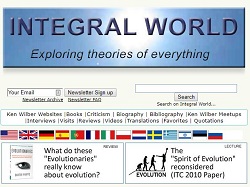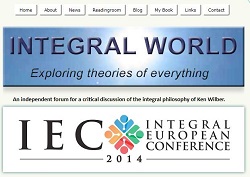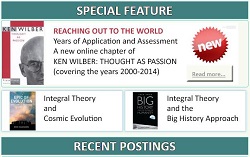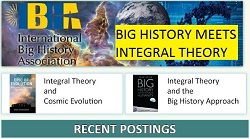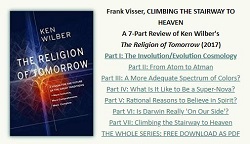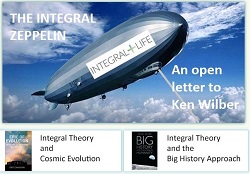TRANSLATE THIS ARTICLE
Integral World: Exploring Theories of Everything
An independent forum for a critical discussion of the integral philosophy of Ken Wilber
SEE MORE ESSAYS WRITTEN BY FRANK VISSER
Part 1 |
Part 2 |
Part 3 |
Part 4 |
Part 5
A Brief History
of Integral World
Part III: Giving More Prominence to Science
Frank Visser
Wilber seems to have created an alternative universe of meaning, in which he can absorb or reject facts of science as he pleases.
It is again time for a next installment of the Brief History of Integral World series. In May 2007 I covered the first ten years of Integral World in "Ten Years of Integral Debate", followed five years later, in March 2013, by "Carving a Niche in the Integral Scene". Again, five years have passed and I would like to summarize this period as "Giving More Prominence to Science", since this has increasingly become the focus of my own research. So we will continue where the second episode left of, in mid-2013.
I will focus primarily on my own contributions to Integral World here, because there is simply too much material to cover in a short space. I apologize for this to the many authors who have contributed essays in the past few years, most specifically written for Integral World, but some reposted from other websites.
2013
In May 2013 I published a long essay covering the largely unexplored territory between Integral Theory and so-called Big History. Big History is an academic discipline which expands the traditional subjects of history to the origin of life on earth (evolution) and the origin of stars and planets (cosmology).
Where Integral Theory is largely expert on the domains of mind and spirit, Big History covers the other two domains of life and matter—but continues its analysis to the emergence of human culture. Both approaches promise to be largely complementary. In practice, both schools claim to offer a coherent narrative of matter, life, mind and culture. In "Integral Theory and the ‘Big History’ Approach" I reviewed Fred Spier's book Big History and the Future of Humanity (2011), which has been a most rewarding experience. It strengthened my conviction that Integral Theory is not grounded in science, and needs to include these studies to justify its claim to be a Theory of Everything.
Two highly critical essays by Jim Andrews were posted: "Ken Wilber on Meditation: A Baffling Babbling of Unending Nonsense" and "Twenty Boomeritis Blunders, Shoddy Scholarship, Salacious Sex, and Sham Spirituality". Not for the faint-hearted! They represent strong criticism that should be on record, eve if only to sharpen the arguments on both sides. These essays show the need for integral fact-checking, in the absence of which Wilber can repeat his unfounded views year after year.
Many highly critical essays appeared about Andrew Cohen, starting with "The "A" List of Andrew Cohen: A Catalog of Trauma and Abuse" by former Cohen student Hal Blacker. Many similar essays would follow in subsequent years. Cohen is one of the gurus sanctioned by Wilber (as a "A Rude Boy"), but more and more signals were visible that all was not well with this community.
At the end of the year, I wrote "Rupert Sheldrake and the Evo-Devo Revolution", in an attempt to see if recent developments in biology had refuted or confirmed Sheldrake's notion of morphogenetic fields. When I asked him for a response he kindly consented and submitted "Morphogenetic Fields, A Reply to Frank Visser", which caused several Integral World authors to join the discussion. A rare phenomenon in these areas, where Wilber has never taken this trouble to respond to criticism—even if only to clarify or qualify his points of view.
2014
Two illuminating essays by Egil Asprem were published this year: "Scientific delusions, or delusions about science?, Review of Rupert Sheldrake's The Science Delusion" and "Blind Spots of Disenchantment, Science, Psychical Research, and Natural Theology in the Early 20th Century". They highlight the history of counter-cultural scientific ideas in the West, and provide context to the understanding of Wilber and Sheldrake. Unfortunately, due to Asprem's busy schedule, these could not be completed.
At the request of my Chinese publisher I wrote an extra chapter for my book Ken Wilber: Thought as Passion (2003), covering the years since the book came out: "Reaching Out to the World, Years of Application and Assessment". In this chapter I covered the infamous Wyatt Earp Episode of 2006, and argued that Wilber's increasingly religious or "Erotic" view of evolution should be critically examined.
In "The Wolf of Wilber Street, Integral Goes $uperhuman" I reflected on Wilber's attempt to offer a self-help program to the mainstream audience, with wild promises of transformation. In "Biased Toward the Marvelous?: Integral Reflections on Thomas Nagel's Mind and Cosmos" I noted the similarities of Wilber and Nagel, a respected atheist philosopher who, like Wilber, questioned the explanatory power of neo-Darwinism with respect to biological complexity (offering no alternative, however).
In "Is the Universe Really Winding Up?" I questioned Wilbers cavalier statements that the universe is not winding down (as the Second Law of Thermodynamics holds), but instead is "winding up", because "simple observation" teaches us that in evolution things get more and more complex (and conscious). This seems to me to be a grave error, which sets Wilbers worldview apart from that of settled science. In the following years I would return again and again to this topic.
My presentation at the 1st Integral European Conference, Budapest, 2014 was "Wilber or Truth?, How to Get Rid of Your Wilber Complex". I argued for a differential approach to the Wilber corpus, separating the strong, weak and wrong aspects. The point of this talk was not, of course, that there's no truth in Wilber's writings, but that we should always go for truth.
Many installments of Hugh Martin's "The Human Odyssey, Our Journey of Life from Infancy to Eternity" were published this year.
In an exchange with Joe Perez called "Proud to be Orange" I defended a rational-critical approach to integral theory. Predictably, more spirituality-minded integralists see this as an illegitimate restriction. Personally I think Integral Theory isn't criticized enough, given its wide scope and claims to being a Theory of Everything.
At the end of the year a second longread about Big History was posted as "Integral Theory and Cosmic Evolution", focussing on the work of astronomer Eric Chaisson. He concluded (contrary to the received integral view and highlighting the blind spot of Integral Theory):
Self-assembly, self-organization, and self-ordering do not exist in Nature. Dynamical processes in which "interacting bodies are autonomously driven into ordered structures" always involve energy.
A contrarion view can be found in Duane Elgin's "Deep Big History", which more emphatically stresses the spiritual nature of the universe, which is a "living system".
2015
Another series of essay by Hugh Martin was published on "Ken Wilber, Joseph Campbell, & The Meaning of Life".
I reposted a series of essays by David Lane from 1997, under the heading of "Ken Wilber's Achilles Heel, The Art of Spiritual Hyperbole", which initially set me on the trail of Wilber criticism. I also posted "Questioning the Entire Edifice, The Integral World Contributions of David Lane" to clarify this often misunderstood strategy.
In "Demystifying Evolution: How do Creationism, Darwinism and Integralism Compare?" I tried to situate Wilber's worldview within the landscape of creation versus evolution. It contains a link to the widely broadcasted 2.5 hour debate (7 million views on YouTube) between creationist Ken Ham and "science guy" Bill Nye, which is quite entertaining to watch. An excercise in cross-level debate if ever there was one! Since Wilber has written extensively on the integration of religion and science, not much has been written about how he compares to the standard points of view in this field. I compared Wilber's accomodationist view in "Wilber vs. Coyne", since Jerry Coyne is a good example of a someone who holds that science and religion (especially when it enters the field of science) are not compatible.
In "Integral Overstretch" I commented on a video series called "Integral in Action with Ken Wilber", hosted by the Conscious2 organization. It exhibited Wilber's disdain for the facts of science when he blurted out, referring to the Second Law of Thermodynamics which holds that existence will end in a state of unproductive equilibrium, "The whole notion that the universe is 'running down' is ridiculous." Wilber seems to have created an alternative universe of meaning, in which he can absorb or reject facts of science as he pleases, not hindered by any scientific expertise in his devoted audience. Most integralists, being therapists or consultants, are scientifically illiterate. Nevertheless, Wilber confidently claims "The integral model is basically complete, nothing fundamental is left out" and "We have created a composite map of the world, a 'super map'."
Jeff Meyerhoff's update of his contribution to the Integral Theory Conference in 2010 was posted at my request, as "Integral Studies and Academia: Barriers and Gateways". Meyerhoff's book Bald Ambition: A Critique of Ken Wilber's Theory of Everything, is widely ignored in the integral community, but is a masterful example of how the Wilber debate should be executed. This ITC essay systematically and constructively sketches what chance Integral Theory has of surviving in the academic world, where institutions are needed to attract students and teachers. Not exactly what one would expect from "integral's worst critic"... He soberly concludes:
Some of the common claims in integral studies such as: the critique of specialization, the importance of spirituality, a role for consciousness and subjectivity, the need to integrate all the sciences, and that there is an overarching direction to evolution, will pose challenges for the acceptance of integral approaches.
2016
Early 2016 Marc Gafni featured prominently in the press due to an article in the New York Times covering his controversial past. I commented on this episode in "What's Love Got to Do with It" and the more theoretical "Does Love Really Make the World Go Round?" Both Gafni and Wilber promote a worldview which is at variance with the standard views of science when it comes to explaining the emergence of complexity. I think tihs deserves more attention, otherwise integral will increasingly generate its own "alternative facts".
A third longread on Big History was published as "Big History and Integral Theory: Ken Wilber Meets Bill Bryson", a paper presented at the Big History Conference held in Amsterdam on July 17th. It compares the strengths and weaknesses of both Integral Theory and Big History and suggests some ways at integrating these big picture models. I concluded with the statement:
I do think that the interface of Big History and Integral Theory is a fruitful area for further study and reflection. Even if they are not easily reduced to each other, by comparing these two inter-disciplinary approaches to human knowledge and experiences potential biases and blind-spots can more easily come to light. If they continue to bask in their own glory this will not happen any time soon.
Pursuing this line of research further, in "Equilibrium is Death", I focussed on the relationships between entropy and evolution, and the paradox of life's complexity. In "Eros as Skyhook", I contrasted Wilber's approach with that of Daniel Dennett, a hard-core neo-Darwinian philosopher.
In "A Brief History of Spiral Dynamics" Albion Butters gave an objective description of the many phases this system has gone through, pioneered by Graves, consolidated by Beck & Cowan and updated by Wilber. He concludes:
As its title admits, this article merely presents a brief introduction to Spiral Dynamics. That said, the general model and the dynamics between the major players have hopefully been laid out in sufficient detail that those who are drawn to delve the system more deeply may do so in a way that best matches their interest. The future of Spiral Dynamics depends on such interest.
Lex Neal's "Integral Relativity: An Update" was posted, which was followed this yaer by "The Necessity of a Tri-Axial Integral Model". Neale's model proposes an expansion of the integral AQAL model to encompass non-local forms of consciousness.
I reposted with persmission of the author Stanley Salthe's essay "Entropy: What Does It Really Mean?", for this concept holds the key to our understanding of evolution and complexity, but is often sorely misunderstood..
2017
A review of Perry Marshall's Evolution 2.0 as "DNA as Proof for God's Existence?" attracted lots of attention and visitors form the field of creationism. Marshall, a creationist with a clear eye for science, covers many areas of evolutionary theory never even mentioned by Wilber (he is content to debunk neo-Darwinism), though it is unclear where he wants to locate his God in the evolutionary process, when he concludes:
Let's try a new rhythm: Let's propose that God (or a supremely powerful being, if that makes you more comfortable) made a rabbit hole so deep, we don't know how far it goes. We only know there's always more to discover. And that's how we break the deadlock between Darwin and Design.
This year Wilber published his Trump and the Post-Truth World, which I reviewed an "A Self-Help Guide for Democrats". I concluded that this little book contained some suggestive insights in the dynamic that brought Trump to victory, but that the story was marred by a hopelessly metaphysical view of evolution and its powers.
David Lane posted a four-part review of this book, under the title "The Missing Nuance", meticulously analyzing Wilber's misuse of science and statistics to accommodate his spiritual view of things. Lane also reviewed Wilber's new book The Religion of Tomorrow under the title "Ken Wilber and 'Moronic' Evolution" (the epithet is Wilber's, not Lane's). He concluded "Make no mistake, Ken Wilber has a serious problem with evolution by natural selection since it fundamentally pulls apart his Integral house of cards."
Of course, I too reviewed this new Wilber book, in seven parts, under the title "Climbing the Stairway to Heaven". In this review series I covered the usual topics I disagree on with Wilber, such as the nature of evolution and the cosmological dynamic behind the emergence of complexity. I also analyzed in-depth the reasons Wilber broken with the color scheme of Spiral Dynamics in 2006, and the merits (or lack thereof) of his new color palette, in "A More Adequate Spectrum of Colors?". I concluded that the new system is an awkward hybrid between the original SD colors and the rainbow spectrum.
Two further essays explore the interface between integral theory and science: "Why Wilber Doesn't Get the Cosmic Energy Economy" and "Why Self-Organization is Not a Cosmic Drive". By now it had become very obvious to me that Wilber was presenting a religious worldview which is at variance with the insights of settled science. He sees evolution and the cosmos at large as driven by a force he calls Eros (another name for God or Spirit), where science holds a more paradoxical view (and therefore more interesting) in which complexity can arise locally, at the expense of much energy-input, in a universe that burns itself up. No cosmic drive towards complexity is needed.
Phil Anderson submitted "A fully holonic meta-theory for the heart of Integral", in which he presented an alternative integral model, touching bases with many other models (Spiral Dynamics, McIntosh, Neale, Cook-Greuter, etc).
Elliot Benjamin's three part series "Is Shambhala a Cult?" covered the recent scandal related to Chögyam Trungpa's son Mipam, who has been accused of sexual misconduct, as so many other modern "gurus" these days. In his always personal and engaging style he documented his participation in this spiritual organization and his later reflections. Benjamin also closely followed the rise (and fall?) of Donald Trump in various essays throughout 2016-2018.
David Long posted a long summary of his exchanges with Corey De Vos, editor (and more) of IntegralLife.com, under the title "Creative Integral Friction", in which he proposed that a change in attitude towards criticism was long overdue. Few have treaded in this minefield, but Long is one of the few brave souls who has the guts to disagree with mainstream integral (even if he subscribes to the main integral principles). Another brother-in-arms is Joseph Dillard, author of Healing Integral, who has started to contribute frequently to Integral World.
2018
Early 2018 Marc Gafni again gained publicity due to his appearance on Dr Phill's show, which I covered in "I Don't Know What the Hell You Are Trying to Say", echoing Dr. Phill's astonishment at Gafni's line of defense against accusations of sexual misbehavior.
In "Looking for The Grand Sequence" I reviewed the book Quarks to Culture by biologist Tyler Volk. I found this approach refreshing for its take on how complexity can arise quite naturally given the physical conditions of the universe. He provides an antidote to overly spiritualist explanations. Another review was published as "Frederic Laloux and His Critics", whose Reinventing Organizations has become a huge bestselling and hit within integral circles, since it used the integral model to clarify what is next for business organizations (becoming "Teal"). I concluded that the book is not as good as the fans say, but definitely not as bad as the critics want us to believe.
I added two new appendices to "An Adequate Spectrum of Colors?" covering the scientific color theories for paint, print and light, and offered a revision of Wilber's color scheme, re-introducing the primary colors Blue and Yellow to balance the preponderance of reddish hues. The appendices are called "Various Scientific Color Models" and "A Suggested Color Revision". Of course, without any illusion that these revisions will be adopted any time soon (the confusion between the models of Wilber and SD is already extensive), but just to set the record straight.
I published an Open Letter to Ken Wilber in "The Integral Zeppelin", arguing that he needs to reconsider his views in three areas: entropy, evolution and the use of colors. Not in the least expecting an answer, I continued with "Why We Need a Secular Integral", in which I expressed my view that the spiritual dimensions of Integral Theory has caused more trouble its mainstream acceptance than it needs. Not because our Western culture doesn't accept spirituality, but because Wilber's misrepresentations of science and his support for dubious spiritual gurus is questionable. In an Integral Life video Wilber characterized these efforts as "extremely conventional" (see "The Joy of Being Called 'Extremely Conventional'")—leaving little doubt that Wilber's "unconventional worldview" has been consolidated over the years into an ideology, which goes unquestioned by integral students.
I reviewed David Christian's book Origin Story in "The Dissipative Universe and the Paradox of Complexity" favorably, because he understands the paradox that we, living in a universe that is obeying the Second Law of Thermodynamics, and is thus "winding down" (to use Wilber's term) can nevertheless increase our complexity and consciousness given enough energy input. This paradoxical insight, lost on Wilber, does justice to the facts of science as we currently know them and highlights the importance of energy-flows—another dimension missing in Integral Theory.
Steve Taylors essay "Beyond Materialism", written at my invitation to balance the many reductionistic essays on this website, attracted quite a lot of comments and two response essays, one by myself and two by David Lane (who wrote his 150th contribution in 10 years to this website).
In the past few years, Joe Corbett has developed his own vision of a "Quantum Cosmology of Consciousness", creatively linking the various states of consciousness with the quantum realms, including dark matter and dark energy. His many iterations of this theme can be found in the Reading Room.
-0-0-0-0-0-
It has become obvious that I am following a different track from most integralists, more aligned to science and less open to wildly speculative spiritual views of the universe. That doesn't mean I don't value spirituality. On the contrary, extraordinary states of consciousness are an interesting field of study. What I do question, is when persons who claim to have experienced these higher forms of consciousness, also claim expertise in these fields of science. It will be interesting to see if this difference of opinion will result in a further cleavage between myself and the integral establishment, or if this can result in a fruitful and creative area of friction, leading to insights that will otherwise rarely be reached.
| 
 Frank Visser, graduated as a psychologist of culture and religion, founded IntegralWorld in 1997. He worked as production manager for various publishing houses and as service manager for various internet companies and lives in Amsterdam. Books: Ken Wilber: Thought as Passion (SUNY, 2003), and The Corona Conspiracy: Combatting Disinformation about the Coronavirus (Kindle, 2020).
Frank Visser, graduated as a psychologist of culture and religion, founded IntegralWorld in 1997. He worked as production manager for various publishing houses and as service manager for various internet companies and lives in Amsterdam. Books: Ken Wilber: Thought as Passion (SUNY, 2003), and The Corona Conspiracy: Combatting Disinformation about the Coronavirus (Kindle, 2020). 